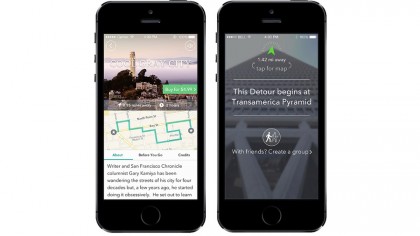The physical web: A hidden world that will change things forever
Bluetooth beacons are the bridge between digital and physical realms
How are beacons making cities smart?
A project by Future Cities Catapult, Guide Dogs and Microsoft used beacons to provide contextual information to people with vision impairment. "This was done via a bone-conducting headset, providing information about the user's surroundings and, for example, information on when the right bus was coming," says Crooks. There are also beacons deployed in London tube stations and train stations. "It's easy to see how beacons could be used across a smart city to help provide not just people with accessibility issues, but also tourists, with information in a way that helps them navigate around a city, in their own language."

It's already happening in museums. "Museums are using beacons for audio guides, for telling visitors more about the exhibits, and for navigating, including the Imperial War Museum in London, the Philadelphia Museum of Art, the Computer History Museum in Mountain View, California, and the Warsaw Uprising Museum," says Longino. "Beacons provide an enriching experience, and they're so much cheaper than traditional audio guides – you just download an app." Even Elvis Presley's Graceland in Memphis uses iBeacons to trigger location-based content within a new multimedia tablet tour on iPads.

Navigating and indoor mapping
Another such example is the Detour app, which provides audio guides of eight world cities (including Berlin, London, New York, Paris and San Francisco) using an augmentation of GPS and beacons to trigger stories as people walk around. "Beacons mean that users don't have to follow a pre-set route and can discover different areas with better granularity than would be possible with GPS," says Crooks. "It also means that the inside of buildings can be added, providing an enhanced user experience."
Indoor mapping is one often overlooked area that the beacon is about to revolutionise, making shopping malls, airports and offices fully navigable in 3D and in terms of people, too. Meeting a colleague in Terminal 1 to catch a flight? Not only will your phone help navigate you around the building, but it can also tell you when your colleague has arrived at the airport.

Beacons at home
The same goes for the home, too; imagine if your phone know that you'd just gone upstairs? Automated lighting, heating and music could follow you from living room to bedroom to bathroom, but leave the music playing in the living room if there's someone still there.
Beacons can be attached to streetlights, signage and other public infrastructure that needs maintenance. "The intelligence can be used to identify when assets are at risk of malfunctioning and help a council assign maintenance workers to address issues before they become problems," says Crooks. "We think there will be an augmentation of IoT technologies, including beacons and other sensor-driven devices."
By adding context and proximity to create a truly physical web, Bluetooth beacons could become the backbone of the smart city, the smart store, the smart office and the smart home, where the digital realm awaits us at every turn.
Sign up to the TechRadar Pro newsletter to get all the top news, opinion, features and guidance your business needs to succeed!
Jamie is a freelance tech, travel and space journalist based in the UK. He’s been writing regularly for Techradar since it was launched in 2008 and also writes regularly for Forbes, The Telegraph, the South China Morning Post, Sky & Telescope and the Sky At Night magazine as well as other Future titles T3, Digital Camera World, All About Space and Space.com. He also edits two of his own websites, TravGear.com and WhenIsTheNextEclipse.com that reflect his obsession with travel gear and solar eclipse travel. He is the author of A Stargazing Program For Beginners (Springer, 2015),
